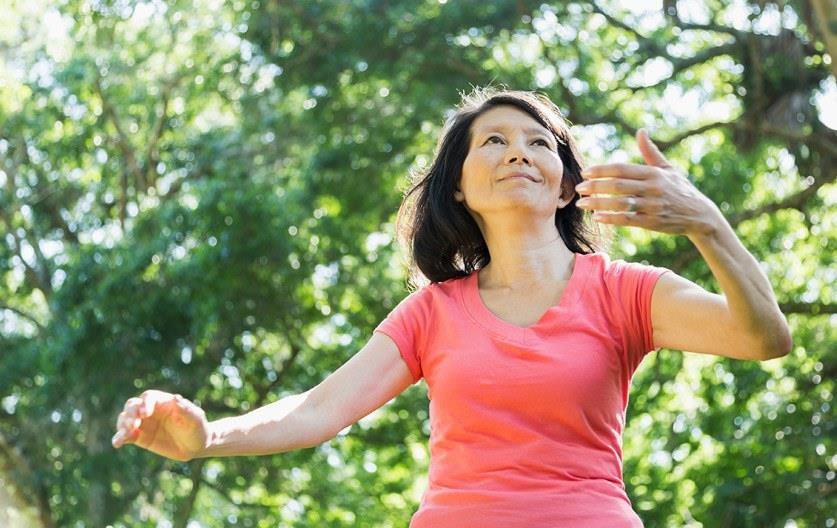- Home
- Mind & body
- Osteoporosis action: How exercising for your bones works
At CBHS we help you manage your health challenges. We believe in offering you the services, support and tools you need to live your best life.
Our Better Living Programs are available to support eligible members towards a healthier lifestyle. Each Better Living Program is subject to its own eligibility criteria.
Contact us for more information and to confirm your eligibility for a program.
Osteoporosis action: How exercising for your bones works

Exercising for fitness? Sure. Exercising for a slimmer waist? Yep. Exercising for healthier bones? Wait … what? Yes, certain physical activities hold real benefits for your skeleton.
While strong bones are important at all stages of life, this is an area of your health that often requires increasing attention with age.
One of the best-known bone problems is osteoporosis. According to the Australian Institute of Health and Welfare, in 2014-15, nearly 10 per cent of Australians aged over 50 reported having osteoporosis, or the related condition osteopenia.
But what exactly is osteoporosis, and how can exercise help to counter its effects?
What is osteoporosis?
Osteoporosis is a condition where our bones become less dense and strong, leading to a higher chance of fractures and breaks.
So, how does this happen? Throughout our lives, the body continuously adds new bone to our skeleton (formation), and removes old bone (resorption). Until a certain point (usually our late 20s), the rate of formation is greater than resorption, leading to high bone density and strength.
After this point, resorption slowly begins to exceed formation. However, if this trend becomes exacerbated (i.e much faster resorption, or much slower formation), osteoporosis can occur.
How can exercising help osteoporosis?
Next, we’ll look at how exercise can help fight osteoporosis. Note, you should talk to a health care professional about any proposed changes to your exercise regime to ensure they’re safe and appropriate.
1. Weight-bearing exercises
Weight-bearing exercises are those that force you to work against gravity by, you guessed it, bearing your own weight. Think hiking and jogging through to badminton and dancing.
One scientific study showed that these exercises are better for increasing bone mineral density (BMD) among elderly osteoporosis patients than non-weight-bearing exercises. The biology behind this is simple - these types of activities put appropriate stress on your bones, stimulating extra calcium deposition and bone-forming cells.
However, a number of factors control how effective these exercises will be:
- Only load-bearing bones will benefit - if the osteoporosis is in your wrists, running won’t help, so target your activities accordingly.
- Greater intensity gives greater results - high impact activities put more stress on bones, so tend to have more pronounced effects. For example, running will put more stress on your bones than walking. Of course, not everyone will be able to complete activities at a higher velocity, so be sure to stick to what’s safe for your body.
- Regularity - a run a month won’t likely help. Real improvements to bone strength require commitment to your exercise schedule.
2. Progressive resistance training
Progressive resistance training (PRT) involves working against a resistance (i.e. a free weight, or elastic band), and gradually increasing the load as your strength improves.
While weight lifting is associated with Schwarzenegger-esque biceps, muscle contraction puts a strain on your bones that causes them to adapt by strengthening.
This is a similar process to that described for weight-bearing exercises, but one particular advantage of progressive resistance training is that it allows you to target specific areas. Osteoporosis Australia recommends focusing on areas prone to osteoporotic fracture, such as the hips and spine.
3. Balancing and mobility exercises
Balancing and mobility exercises won’t build bone strength, but they do help reduce the risk of falling, according to Osteoporosis Australia.
Falls are very dangerous, for those with weaker and more brittle bones, so it’s worth trying some of the following suggestions:
- Taichi - this ancient Chinese practice centres on integrating the mind and the body, and gaining control over your movements. It’s also said to be highly relaxing, so a real win-win!
- Heel-to-toe walking - by making the conscious decision to plant your heel first when walking, you can give yourself a much more stable base than a standard gait.
- Standing on one leg - not much explanation required here, but the simple act of practicing standing on one leg may improve your balance!
Chances are, you’re already incorporating aspects of these activities in your exercise regime, but hopefully this article has inspired you to try new ways of protecting your bones against osteoporosis!
If you hold CBHS Hospital cover with CBHS you may qualify for a Better Living program. There is a Better Living program designed specifically for people at risk of, or diagnosed with, osteoporosis. For more information, contact the CBHS Wellness Team on 1300 174 534 or at wellness@cbhs.com.au
Sources
- https://www.aihw.gov.au/reports/chronic-musculoskeletal-conditions/estimating-the-prevalence-of-osteoporosis-in-austr/contents/summary
- https://www.bones.nih.gov/health-info/bone/osteoporosis/overview
- https://www.bones.nih.gov/health-info/bone/bone-health/exercise/exercise-your-bone-health
- https://www.ncbi.nlm.nih.gov/pmc/articles/PMC4214007/
- https://www.cochrane.org/CD002759/MUSKINJ_progressive-resistance-strength-training-for-improving-physical-function-in-older-adults
- https://www.osteoporosis.org.au/exercise
- https://taichiforhealthinstitute.org/what-is-tai-chi/
- https://youtu.be/fhZUQ6ZydA4
All information contained in this article is intended for general information purposes only. The information provided should not be relied upon as medical advice and does not supersede or replace a consultation with a suitably qualified healthcare professional.
Health and wellbeing
programs & support
You Belong to More with CBHS Hospital cover:
- Greater choice over your health options including who treats you
- Get care at home with Hospital Substitute Treatment program
- Free health and wellbeing programs to support your health challenges
Live your healthiest, happiest life with CBHS Extras cover:
- Benefits for proactive health checks e.g. bone density tests, eye screenings
- Keep up your care with telehealth and digital options
- Save on dental and optical with CBHS Choice Network providers
